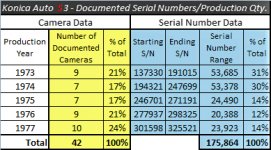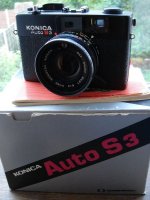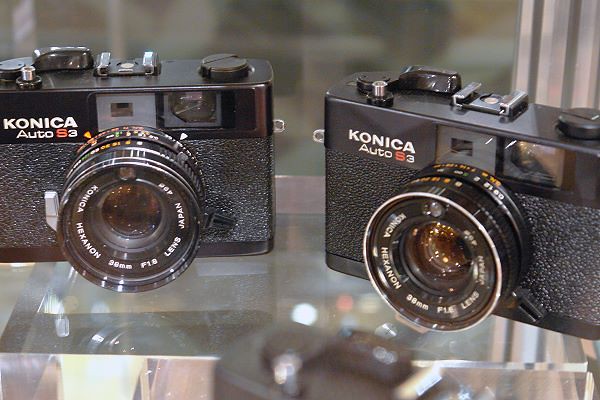Conclusions from this study
Conclusions from this study
Never considered this quest would be such a challenge, but it has actually been an interesting journey. With 32 documented cameras, it turns out that ebay has been my best source of information:
1. 41% of total from ebay
2. 28% from RFF
3. 19% from Flickr
4. 13% from friends and acquaintances
Information I’ve researched indicated that production ranged from 1973 through 1980 however this date range cannot be validated based upon the 32 cameras documented that range from 1973 through 1977. More likely is that the camera was maintained on price lists and available at retail as sell-through until 1980.
Data distribution over the years reflects that 1973 was the year when most of these cameras were produced. This makes sense in that Konica would need to have seeded a global supply chain up front. The number of cameras/year was calculated by comparing first to last serial number reported in the respective year. Certainly there are gaps in the data with a sample of only 32, but it does reveal some interesting trends:
1. 1973: 42% of total = 53,685 cameras
2. 1974: 4% of total = 5,192 cameras
3. 1975: 19% of total = 24,490 cameras
4. 1976: 16% of total = 20,388 cameras
5. 1977: 19% of total = 23,663 cameras
The earliest serial number reported was 137330 from Sweden, and the latest was 325261 from England reported by wakarimasen on this forum. It seems that the camera was first and last distributed in Europe and the Japanese domestic markets, with early numbers before 190000, and late numbers after 300000 all coming from these markets. US market cameras seem to have largely been built from 1973 through 1976.
Earliest and latest serial numbers documented span a range of 187,931 cameras. Based upon this, all indications are that roughly 200,000 of these cameras were produced over five years of production. Contrasting with FLRF competitors production ranging in the millions, (Yashica Electro 35 series, and Canon Cannonet G-III QL 17 the reigning champions), it’s easy to understand why Auto S3’s are tough to find today and command high prices, especially in pristine condition. Many of the examples that show up on ebay these days are cobbled warhorses, or bricks offered by folks looking to cash-in. A hint: if the seller can’t guarantee that the camera is fully functional, it’s a pretty long shot to find a good one.
A key takeaway for me is that it’s probably not a good bet to pick-up a partially functional Auto S3 with hopes to restore it with acquisition of a parts camera. With such small production numbers, an Auto S3 in any condition brings good money and the part(s) broken on your camera will likely be the same parts broken on parts cameras: an Auto S3 without a functional meter is a bookend.




